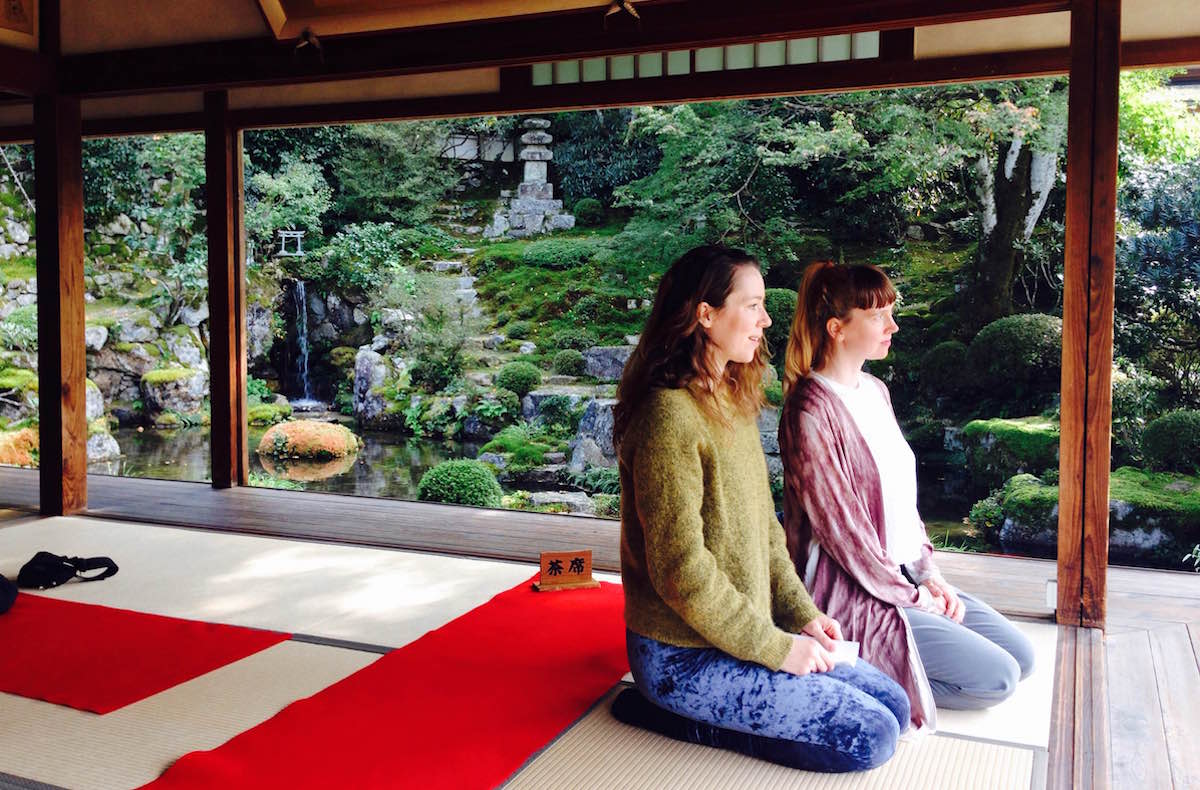レジデンス後のコメント 〜 Iteke and Tjitske Hemkesより
KYOTO MACHIYA AIR 2015(京町家AIR2015)の滞在アーティストIteke and Tjitske Hemkesから本レジデンス後にメッセージが届いています。アーティストとしてオランダで活動する姉妹は、今回の滞在で何に触発され、それを自らの表現へと紡いでいったのか。どうぞご覧ください。
(なお、京町家AIR2015活動記録集には紙面の都合上、以下の本文より抜粋したものを掲載しています。)
このアーティスト・イン・レジデンス・プログラムの始まりに私達は様々な目的を頭にしました。日本の豊かな文化に多くのインスピレーションを受けながら、今回のレジデンスは私達の姉妹としてのコラボレーションを発掘する貴重な機会になりました。この期間に、私達はもっと自由で気楽な制作プロセスを追及していきたいと考えました。
たが、私達の最も大切なインスピレーションの源は町家に暮らしていて、町家で働いている体験でした。このように、私達は日本の文化をもっと深く、もっと本格的に経験できました。日本に行く多くの外国人は日本文化の表面だけにしか触れることができないので、このような本格的な経験ができて光栄でした。
一週間、日本を旅行してから、私達は京都で多くのインスピレーションを得ました。町でもインスピレーションを得ましたが、町家に住むことによっても大きなインパクトを受けました。町家は日本を小さく表現する家のようでした。
町家は不思議なコントラストを沢山含んでいます。町家は手作りの材料から作られましたが、町家の中にも電子化された日本語での音声が出る電子パネルも設置されています。他のコントラストは建物の美しさと建物の暗さでした。窓が多いですが、いつも障子がついていますので、部屋は暗くて重いです。これは私達が慣れているオランダの家の逆です。電気の照明がありますが、それは非常にまぶしくて、伝統的な家の雰囲気に反します。町家の照明を変えるのは難しく、フィルターで照明を暗くしようともしました。
他のオランダの家と異なるところの一つは家具があまりなくて、特に床で時間を過ごすこと。靴をぬいで床を歩いたら、自分の動きと町家の細かいところを意識しました。私達の町家への意識がもっと敏感になって、私達と町家の関係が深まって、本当に生きている家のようでした。
町家は自然の空気循環があるので、呼吸しているようでした。家の伝統的な要素を見て、私達はその長い歴史やそれを含んだ物語を意識しました。私達は織物の産業が盛んな西陣地区に滞在することができて、とてもラッキーでした。そこで、私達は染織を専門とする町家での小さい会社に訪問することができ、絞り染め、柿渋染め、藍染等の伝統的な技法を紹介して頂きました。
他に大切になるインスピレーションの一つは詫び寂びという美意識でした。私達の制作プロセスに対して違う態度をとりたいという意図に合っていると考えました。
特に、不完全さを受け入れることや日本の禅宗にある価値感に惹かれました。
そして、日本の伝統的な茶道にも魅力を感じました。狭い入り口を通り小さな部屋に入ることは幻想的な体験でした。部屋の中にいることは母胎にいるような安らぎある体験でした。「今」と「ここ」だけの経験になる時間と空間といった概念から離れた場所でした。その中で、どんな動きもルールに従って行われました。理解できなかった文化と言語のある国にいて、自分達がコントロールできなかったことが沢山あると感じましたが、逆にこの自分達がコントロールできなかったことを許容することで、安堵のような気持ちを感じていました。
私達の制作のプロセスでコントロールを解き放ったら、作品はどうなるのか知りたくなりました。そこで、私達は紙を見ないで、お互いの顔を描くという実験を始めました。それから、私達はこの実験を3次元で試みて、目隠しをしながら、茶器組を制作しました。私達はこの半分無意識な世界で生まれた形に感激しました。
私達はこのプロセスを「Let Go, Get Lo」という実験的なワークショップとして企画し、上京区の住民や一般の方々にも参加してもらいました。そして、そのワークショップで出来上がった作品を「Space out of space」というインストレーションと「Ghost machiya」という映像作品といった私達の他の作品と共にANEWAL Galleryで展示しました。
Iteke and Tjitske Hemkes
At the start of this residency we had several goals in mind. Besides getting inspired by Japans rich cultural climate, we saw this residency as the perfect opportunity to explore our strong sister-bond in a artistic collaboration. During this period we where also aiming to develop a more spontanious and care-free approach to our work process. But our most essential source of inspiration was the fact that we lived and worked in a traditional Machiya. For us this was a way to experience the Japanese culture on a deeper and more authentic level. We felt privileged because most foreigners only get to touch the surface of what Japan is all about.
After we had been traveling though the country for a week, we gathered a lot of new impressions in Kyoto itself. We got more and more inspired by the city but also living in our Machiya made a big impact on us. In a nutshell: the Machiya is like Japan in small. It is full of puzzling contrasts. Like how everything is made from handcrafted materials but at the same time electric dashboards are integrated all over, with a computerized voice talking to you in Japanese. Another striking contrast is the beauty of the building versus the darkness. There are many windows but they are permanently shaded, which makes the rooms dark and gloomy. This is the opposite to what we are used to in Holland. Luckily there are lights but they are extremely bright. A huge contrast to the old, handmade, sensitive house. It was difficult to understand the lighting situation, which seems to be common for Machiyas nowadays and we tried to dim the light with improvised filters. Another big change for us was to live mainly on the floor with hardly any furniture. Removing your shoes in the house, tip toing around and constantly aware of your movements, creating a feeling for each centimeter of the Machiya. This brought us to a more sensitive mind set, in which we grew a personal relationship with the house. It really felt as if it was alive. With its natural circulation of air it was literally breathing. With its traditional elements it was also constantly reminding us of its long history and in that way the house was telling us a lot of stories.
We were lucky to live in the Nishijin area, with its specialization in the textile business. We had the opportunity to visit several small companies in Machiyas, that specialized in weaving and dyeing processes. Also we got introduced with several traditional techniques like Shibori and dyeing with indigo and kaki.
Another important inspiration to us was the wabi sabi philosophy. It resonated with our intention to have a different attitude towards our work process. Especially the aspect of appreciating imperfections and the zen attitude towards things appealed to us. So did the ceremonial art of making tea. It was magical to enter the small tearoom, squeezing through a tiny entrance. Inside it felt like being in a womb where everything is serene. It’s a place outside the concepts of time and space, only experiencing the here and now, where every movement is ritually choreographed.
Being in a different culture with a language we don’t understand, also made us feel very out of control, but as we surrendered to it we noticed we could really enjoy it. This made us curious what would happen if we would take away control in our artistic process. We started to make portraits of each other without looking at the paper. Then we moved to 3 dimensional shapes by making a tea set in a ceramic workshop while being blindfolded. We where very intrigued by the shapes that appeared from this half unconscious world.
We incorporated our process into a workshop.experiment, titled ‘Let Go, Get Lo’, that we gave during Kamigyo Open Week, involving local residents. The results of this workshop we exhibited in Anewal gallery, together with our other works: the ’Space out of space’ and a video called ‘Ghost Machiya’.
Iteke and Tjitske Hemkes
「京町家アーティスト・イン・レジデンス2015」
参加作家:ジッケ・ファン・ローン、イテケとチツケ・ヘムケス(計3名)
アーティスト滞在期間:9/25~12/16
成果発表展:12/4~6
レジデンス:ANEWAL Gallery、米田邸
共催:
日本カルチャーセンター・アムステルダム(‘t Japan Cultureel Centrum)
公益財団法人京都市景観・まちづくりセンター
特定非営利活動法人ANEWAL Gallery
後援:オランダ王国大使館、在大阪・神戸オランダ総領事館

